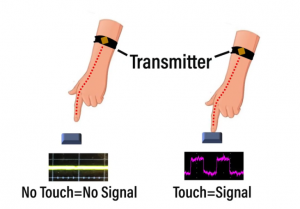Sending Information Through Touch
by Phyllis Shen
Sending Information Through Touch
Recent developments in technology have allowed people to scan objects without contact. For example, contactless payments have allowed grocery shoppers to pay using a credit or debit card without their card touching any surfaces, which has been a beneficial health and safety measure during the COVID-19 pandemic. However, these transactions still require the user to take a smartphone or payment card out of their pockets or purses in order to scan them in the card reader. In addition, information from these transactions often emit Bluetooth signals, allowing them to be hacked by anyone receiving those signals from a thirty-foot radius. Because of this, researchers at Purdue University have been working to develop technology that allows users to transfer data to devices with a simple touch on the device screen.
Rather than measuring biometric data, such as fingerprint patterns, this technology is able to send and receive stored information through digital data signals, which are transferred through smartphones, smartwatches, and medical devices. These signals exist in electromagnetic waves that are lower in frequency than typical Bluetooth signals. Unlike Bluetooth signals, these signals can only be transmitted between devices through direct touch; hovering your finger above the device would not allow the signals to be transferred to that device, thus preventing nearby hackers from intercepting sensitive data, such as personal identification information, payment credentials, and photographs. This capability was demonstrated by the Purdue University researchers by having multiple devices actively try to read data from a person’s finger, with a light on each device illuminating each time the data was received by the device. The light on the devices only lit up when the finger came in contact with the device. This showed that the devices were only able to receive data if the person actually touched the device, even if they held their finger only centimeters from a device trying to collect their data.

Digital signals can only be transmitted through direct, closed contact with the device, adding a layer of security to transferring sensitive, personal information to devices. Courtesy of Purdue Engineering.
This technology brings added convenience to many everyday tasks of ordinary individuals. It allows users to transfer payment to others without having to fumble for a payment card or smartphone. Instead, the user can simply touch a screen to send their payment information to a card reader. In addition, this technology can also replace the need for keys and fobs on college campuses and in dormitories. Right now, a physical key or fob is needed in order for students and faculty to scan their way into a building; however, this technology can allow users to gain access to a building through a simple touch using their finger on doorknobs or fob readers.
Currently, there are some limitations to this technology that would prevent its widespread use in society. This single-touch method of transferring data would require investments in new devices that can not only sense the location of the user’s touch on its screen, but can also interpret digital signals that are sent through that touch. There would also need to be a convenient way for users to turn off the data-sending capabilities of their fingertips to avoid accidentally sending their personal information to every data-reading surface that they encounter. Nevertheless, this new technology brings the exciting possibility of individuals being able to store personal data on themselves in a safe, secure way, allowing them to carry fewer personal items while conveniently accessing the many services that have become an integral part of our everyday functioning.
Works Cited
Purdue Engineering. “Digital Communication through Human Touch.” YouTube, December 3, 2020 from https://www.youtube.com/watch?v=-2oscW5i5DQ&feature=youtu.be.
Purdue University. (2020, December 3). Tech makes it possible to digitally communicate through human touch. ScienceDaily. Retrieved December 21, 2020 from www.sciencedaily.com/releases/2020/12/201203173427.htm